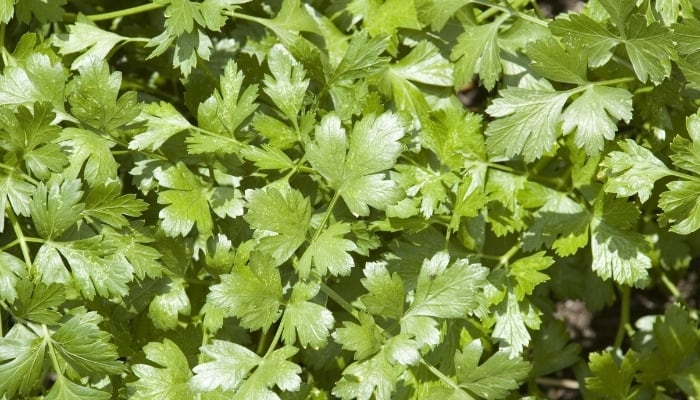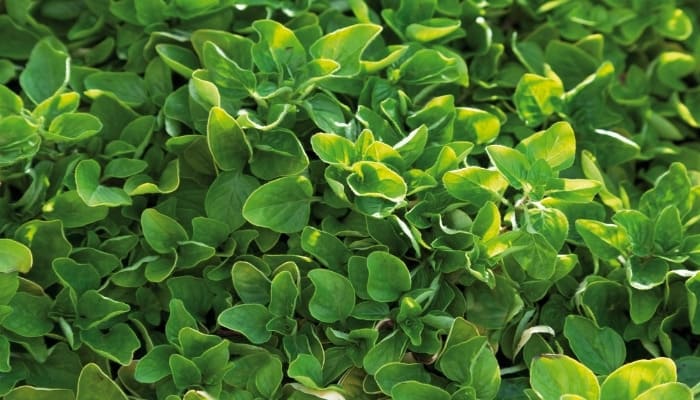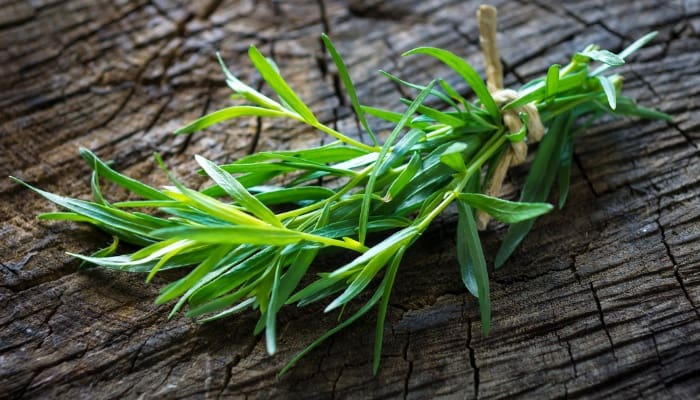Are you interested in trying your hand at herb-growing? That’s fantastic! Growing herbs is an excellent method to experiment with your hydroponics system on a smaller scale, as certain herbs can be harvested in just a few weeks.
What’s more, studies show that herbs grown hydroponically even taste better compared to field-grown ones too, so why wouldn’t you want to start a mini herb garden in your kitchen?
We’ve rounded up the best herbs to grow hydroponically and their growth rates, plus the best-growing medium for herbs, tips on harvesting, and more.
Hydroponic Herbs at a Glance
1. Basil

Basil enhances the flavor of virtually any savory dish, and there are around 150 different varieties of basil to choose from!
Basil is one of the most rewarding herbs to grow hydroponically, so you can’t go wrong with this choice.
Keep this warm-weather herb in 70-80°F conditions, and you’ll be harvesting fresh basil leaves in no time.
2. Chervil

Nicknamed French parsley, this herb tastes wonderful when blended, so add it lovingly to soups, stews, and pasta dishes!
Chervil loves its nitrogen, so look for a nitrogen-rich hydroponic nutrient solution (this is ideal for cilantro too).
3. Chives

Their delectable oniony taste makes chives an irresistible pairing with many foods — they’ll also mature pretty fast with excellent care.
Their small height and size make them the perfect herb for hydroponic towers, and they love light (at least 12 hours of it a day!).
4. Cilantro

Cilantro loves a specific pH range of 6.5 and 6.7, so it’s worth investing in a good pH testing kit to grow this zingy herb.
It isn’t fussy when temperatures are concerned though — it can fare well anywhere between 40 and 75°F, though keep temps in the 60s for faster germination.
5. Dill

Dill packs that sharp aromatic punch that livens up bland fish and veggies.
This bushy herb grows particularly well in moist rockwool medium and can grow up to 3 feet tall, so bear this in mind when choosing your hydroponics system!
6. Fennel

Very similar in appearance to dill, fennel can also reach high heights for an herb (up to 4 feet!). Ten hours of daily light is all fennel needs, and a pH range of 6.4-6.8 will be appreciated.
Tip: You can eat the bulb of fennel plants too once it has matured to the size of a tennis ball.
7. Horseradish

This distinctive deep-rooted herb can be a challenge in modest hydroponic setups, so a 5-gallon bucket reservoir may be more appropriate.
Some hydroponic horseradish gardeners (try saying that fast!) have had luck using a perlite and wick water system to sidestep root rot.
8. Lavender

An ebb-and-flow system is best for lavender as it prefers hot, dry conditions, so keep the surrounding air well-ventilated as humidity may kill it.
Opt for a dwarf variety of this gorgeous, soothing herb and provide at least 6 hours of full sunlight every day.
9. Lemon Balm

This tasty versatile herb can be used to flavor savory dishes, desserts, and teas. Lemon balm grows fairly quickly from seed too, so it won’t be long before you’re adding it to your hydroponic garden.
It also grows well in a forgiving pH range of 5.6-9.0, making this one of the more low-maintenance herbs!
I use lemon balm to keep mosquitoes away when gardening outdoors. Just pinch of a few leaves, and rub them on your exposed skin for an all-natural repellent. It works like a charm!
10. Lemongrass

This sharp citrussy herb doesn’t take long to germinate from seed and can achieve large, bushy growth with good care, so be ready to prune the leaves to prevent overcrowding.
The roots of lemongrass are even edible too, so it’s zero waste with this tangy, delicious plant!
11. Marjoram

Marjoram has a sweet and subtle flavor similar to oregano, and it goes great with meat, fish, and vegetables and is great to use in stuffing.
This herb won’t take much light to prosper. Just be sure to remove flower buds as you spot them to encourage more leaves and prevent the plant from going to seed.
12. Mint

Compared with soil-grown mint, growing this super versatile herb hydroponically will see much fuller, more generous foliage.
Because mint is classed as a semi-aquatic plant, mint is also super easy to grow, even for the beginner hydroponic gardener. Provide 14-16 hours of daily light for best results, and harvest your mint often to encourage bushier growth.
Try growing different varieties, such as peppermint, spearmint, apple mint, chocolate mint, etc., to see which scents and flavors you prefer.
13. Oregano

Delicious when dried or eaten fresh, this tasty herb also has antioxidants, cancer-fighting properties, and pest-repelling properties (aphids detest it!).
Make it happy by keeping in temps between 55 and 70°F and providing a long light cycle of 12-14 hours.
14. Parsley

This nutrient-rich antibacterial herb is a classic tasty garnish, but so much of its flavor is lost when it’s no longer fresh, so it’s a top choice for hydroponic growing.
It’s super forgiving in that it can survive in chilly temps (down to 12°F!), but ideally, keep things between 60 and 65°F for happy and healthy parsley.
15. Rosemary

Delicate rosemary is a slow-grower but well worth the wait for its many medicinal benefits.
Bear in mind that rosemary can be prone to root rot in perpetually wet conditions, so an aeroponics or ebb-and-flow system may be best.
16. Sage

Sage adds that delicious touch to stuffing and meat dishes, especially around the holidays.
This delicious herb is super slow to mature (especially when grown from seed!), so take sage cuttings for growth in your hydroponic garden, and provide at least 12 hours of daily sunlight for best results.
17. Savory

Similar in taste to sage, savory is a herb that goes well in many savory recipes from soups and stews to bean-based dishes.
As this herb doesn’t like to get its feet wet, an aeroponic or NFT (nutrient film technique) hydroponic system would be best.
18. Stevia

Nicknamed “candy leaf,” stevia is a popular drink sweetener and around 250-300 times sweeter than sugar in its purest form!
Plant lots of seeds when starting stevia as around half of them will struggle to germinate.
It also takes 2 months to mature into its optimal sweet taste, so provide this herb with 14-16 hours of artificial light for a helping hand.
Harvest frequently, and pinch off flower heads when they appear as they will cause the leaves to develop a bitter taste.
19. Tarragon

Great in fish dishes and buttery sauces, sweet and aromatic tarragon will grow best in a pH range of 6.5-7.5.
For great results, keep temperatures between 64 and 69°F, and opt for an ebb-and-flow hydroponic system to grow your tarragon.
20. Thyme

In nature, thyme is accustomed to very poor soil. This is good news for hydroponic growth as this herb can cope with around half the average dose of nutrients.
In fact, it grows better with fewer nutrients, so keep this in mind if you are planning to grow it alongside herbs that prefer higher nutrient concentrations.
21. Watercress

This slightly spicy, peppery herb is perfect in sandwiches and salads, and its semi-aquatic nature makes it ideally suited to traditional hydroponic systems. It’s also a superfood with heart, bone, and immune benefits!
Though it can withstand low temperatures of 46°F, keep it within 77-86°F to see lush growth, and try to maintain an ideal pH range of 6.5 and 6.8.
Best Hydroponic System for Herbs
As we’ve discovered, certain herbs suit different systems due to their low tolerance for wet roots or preference for dry conditions, such as lavender and rosemary preferring ebb-and-flow systems.
Generally, the best hydroponic systems for growing herbs include the Ebb and Flow method, DWC system, and mason jar method.
Ebb-and-flow: This involves flooding the plant roots 3-4 times a day with nutrient-rich water and draining it away to expose the roots to fresh oxygen.
DWC (Deep water Culture): This method suspends plant roots in a solution of nutrients and well-oxygenated water and does not use a growing medium.
Mason Jar system: This is a simple budget-friendly option that involves placing the chosen herb seedling in a mesh pot of growing medium inside a mason jar filled with nutrient-rich water.
Growing Mediums for Herbs
The best growing medium is one that will hold onto water and nutrients with a stable, neutral pH.
Some of the most popular mediums for herbs are rockwool (fibers spun from basaltic rock), coco peat (made from coconut fiber), perlite (lightweight granules of volcanic rock), and hydroton (clay pebbles/balls with a light honeycomb center).
Tip: Flush your growing medium every week or so to remove any excess nutrients that your herbs haven’t absorbed.
Starting Seeds
Certain herbs like sage should be started via cuttings as seed germination rates are so slow and poor, but most plants used in hydroponics can be started from seed beforehand.
To do this, lightly spray your selected seeds with water, and place 3-4 into each cell or plug of a seed starter tray.
Keep the seeds covered in a humidity dome, and maintain their optimum temperature for as long as the packet indicates.
Depending on the plant type, germination may occur anywhere between 3 days and 3 weeks. Once germinated and displaying a true set of leaves, they can then be transferred to their hydroponic systems!
Tips for Harvesting Hydroponic Herbs
- Use small clean scissors or micro pruning shears to cut off individual leaves at the base of the plant, or take a 4-6 inch section from the top of each stem.
- Avoid stressing out your plant by harvesting a little at a time.
- Maintain temperatures roughly between 65 and 70°F for a decent crop.
- Wait until herbs have reached full maturity before harvesting, but do so before they begin to flower as this is the peak period for flavor and aroma.
Closing Thoughts
If you want to grow herbs hydroponically without any soil at all, you can see that there are many delicious herbs to grow indoors using various hydroponic methods.
The best hydroponic system for you will depend on your budget, space, and chosen herb as some fare better with certain systems. Most of the above herbs though can be happily grown using an easy small-scale mason jar garden setup!
Whichever herb you fancy growing, be sure to provide it with plenty of natural sunlight where possible, or use supplementary grow lights to encourage a bountiful herb harvest!

